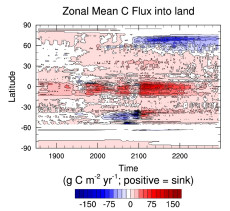In Climatic Tug of War, Carbon From Thawing Permafrost Wins
Earth System Model Simulations Run at NERSC Show Lopsided Results
March 18, 2015
dakrotz@lbl.gov, 510-486-4019

Zonal-mean C fluxes for transient, fully‐forced, coupled C-N run with decomposable deep C. Net high latitude fluxes associated with permafrost thaw persist long after the thaw has occurred and are on same order as tropical C uptake due to CO₂ fertilization and changing land‐use; this represents an important aspect of the global terrestrial carbon cycle response to CO2 emissions.
There’s a carbon showdown brewing in the Arctic as Earth’s climate changes. On one side, thawing permafrost could release enormous amounts of long-frozen carbon into the atmosphere. On the opposing side, as high-latitude regions warm, plants will grow more quickly, which means they’ll take in more carbon from the atmosphere.
Whichever side wins will have a big impact on the carbon cycle and the planet’s climate. If the balance tips in favor of permafrost-released carbon, climate change could accelerate. If the balance tips in favor of carbon-consuming plants, climate change could slow down.
Turns out the result will be lopsided. There will be a lot more carbon released from thawing permafrost than the amount taken in by more Arctic vegetation, according to new computer simulations conducted by scientists from the U.S. Department of Energy’s Lawrence Berkeley National Laboratory (Berkeley Lab). The terrestrial ecosystem portion of the Earth system model simulations were conducted at NERSC.
The findings are from an Earth system model that is the first to represent permafrost processes as well as the dynamics of carbon and nitrogen in the soil. Simulations using the model showed that by the year 2300, if climate change continues unchecked, the net loss of carbon to the atmosphere from Arctic permafrost would range from between 21 petagrams and 164 petagrams. That’s equivalent to between two years and 16 years of human-induced CO2 emissions.
The scientists included nitrogen dynamics in the model because, as permafrost thaws, nitrogen trapped in deeper soil layers (below one meter underground) will decompose and become available to fertilize plants. At the same time, organic carbon frozen in deeper soil layers will decompose and enter the atmosphere.
“The big question has been: Which side wins? And we found the rate of permafrost thaw and its effect on the decomposition of deep carbon will have a much bigger impact on the carbon cycle than the availability of deep nitrogen and its ability to spark plant growth,” said Charles Koven of Berkeley Lab’s Earth Sciences Division.
Koven conducted the research with fellow Berkeley Lab scientist William Riley and David Lawrence of the National Center for Atmospheric Research. They recently reported their research in the Proceedings of the National Academy of Sciences.
The scientists believe that nitrogen’s relatively small impact on the carbon cycle is due to the fact that deeper layers of permafrost won’t thaw until the fall or even early winter, when summer’s warmth finally reaches more than one meter below ground. At that stage in the growing season, the deep nitrogen that decomposes and becomes available will have few plants to fertilize.
The model’s output also highlights uncertainties in the science. After all, the simulations found that between 21 petagrams and 164 petagrams of carbon will be released to the atmosphere, which is a big range. The scientists say that more field and lab research is needed to determine how carbon-decomposition dynamics work in deep layers of permafrost versus at the surface, including the role of microbes, minerals and plant roots.
“These simulations allow us to identify processes that seem to have a lot of leverage on climate change, and which we need to explore further,” said Koven.
About NERSC and Berkeley Lab
The National Energy Research Scientific Computing Center (NERSC) is a U.S. Department of Energy Office of Science User Facility that serves as the primary high performance computing center for scientific research sponsored by the Office of Science. Located at Lawrence Berkeley National Laboratory, NERSC serves almost 10,000 scientists at national laboratories and universities researching a wide range of problems in climate, fusion energy, materials science, physics, chemistry, computational biology, and other disciplines. Berkeley Lab is a DOE national laboratory located in Berkeley, California. It conducts unclassified scientific research and is managed by the University of California for the U.S. Department of Energy. »Learn more about computing sciences at Berkeley Lab.







